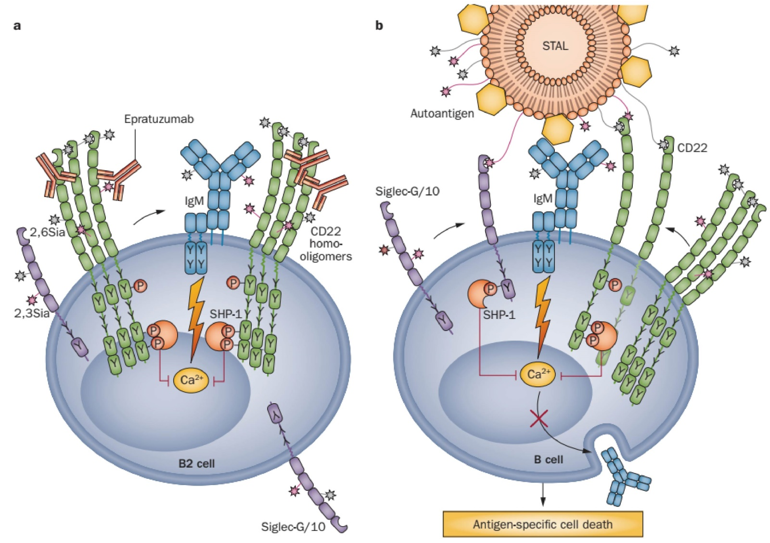
Our promise to you:
Guaranteed product quality, expert customer support.
 24x7 CUSTOMER SERVICE
24x7 CUSTOMER SERVICE
 CONTACT US TO ORDER
CONTACT US TO ORDER
CD22 Gene Editing 
CD22 is a member of the sialic acid-binding immunoglobulin-like lectin (Siglec) receptor family. CD22 is constitutively expressed on B cells and act as inhibitory co-receptors of the B-cell antigen receptor (BCR) by inhibiting the calcium (Ca2+) response, resulting from BCR crosslinking through its specific antigen. Through conserved tyrosine residues in immunoreceptor tyrosine-based inhibitory motifs (ITIMs) located in the intracellular tail, CD22 can activate phosphatases, which dephosphorylate positive components of the BCR signalling cascade to result in a dampening of the BCR signal. Therefore, CD22 deficiencies and genetic variants are associated with hyperactive B cells and autoimmune disease.
Biological Functions of CD22
CD22 is the outstanding inhibitor of the BCR signal in conventional (B2) cells. Antigen-mediated BCR crosslinking causes rapid tyrosine phosphorylation of CD22 via the tyrosine kinase Lyn, thus recruiting and activating the SH2-domain-containing tyrosine phosphatase, SHP-1. Subsequently, SHP-1 dephosphorylates positive activators of the Ca2+ response, such as CD19 or B-cell linker protein, and promotes Ca2+ efflux from the cell. The results from studies in mice with mutated CD22-ITIM sequences suggest that efficient inhibition by CD22 requires all three ITIM sequences. Nevertheless, the mutation of the three ITIMs does not reach the same level of Ca2+ elevation as in CD22-deficient mice, indicating a role for the other three tyrosines of the CD22 cytoplasmic tail in Ca2+ inhibition to prevent overstimulation of B cells.
The inhibitory function of CD22 and its restricted expression on B cells make CD22 an attractive target for B-cell depletion in autoimmune diseases and B-cell-derived malignancies. Many therapeutic approaches in development harness B-cell inhibition through CD22 to induce anergy or tolerance, or to deplete dysregulated B cells through CD22 targeting via either small molecules or antibody-drug conjugates. Constitutive CD22 clathrin-mediated endocytosis allows targeted delivery of immunotoxins to treat B-cell-related blood cancers and autoimmune diseases.
CD22 as Therapeutic Targets
CD22 is expressed on the surface of most B-cell leukemias and lymphomas and thus has been explored as a target for antibody-based therapies. Currently, a variety of antiCD22 monoclonal antibody-based therapies are under development. The use of high-affinity synthetic CD22 ligands that are derived from sialic acids is another way to target CD22 on human B cells in systemic autoimmune diseases. These synthetic ligands, as dimers or oligomers, can bind and crosslink CD22 on the B-cell surfaces away from BCRs, and induce enhanced Ca2+ signalling. Theoretically, the release from CD22 inhibition could induce an excessively strong BCR response, which could then lead to apoptosis of B cells, as has been shown for CD22-deficient B cells in vitro. Besides, B-cell lymphoma cells can efficiently be killed in vitro, when these dimeric or oligomeric sialosides are coupled to toxins. Moreover, STALs (SIGLEC-engaging tolerance inducing antigenic liposomes) were developed, which are liposomes displaying CD22 ligands and protein antigens together to induce B-cell tolerance. Treatment of mice with these STALs induced antigen-specific suppression of immune responses, caused by CD22-mediated and Siglec-G-mediated suppression of BCR signalling, and finally led to specific B cell apoptosis.
 Figure 1. Targeting CD22 by antibodies and liposomes. (Müller J, Nitschke L., 2014)
Figure 1. Targeting CD22 by antibodies and liposomes. (Müller J, Nitschke L., 2014)
CD22 Gene Editing Services
CRISPR/Cas9 PlatformCB at Creative Biogene is dedicated to offering comprehensive CRISPR/Cas9 gene editing services and products for academic research, biotech research and pharmaceutical drug discovery. With deep gene editing knowledge and extensive experience in experimental operation and data processing, we help you effectively control CD22 genes knockout/knockin/point mutation in cells or animals via CRISPR/Cas9 technology.
| Service | Details | Alternative cell lines or animal species |
| CD22 Gene Editing Cell Line Generation | gRNA design and synthesis Transfect the cell lines you're interested Select the high expression cells and sort monoclonal cell Validate the knockout/knockin/point mutation of CD22 by PCR and sequencing Provide cryogenic preserved vials of stable cells and final reports | HEK239T, Hela, HepG2, U87, Ba/F3, CHO, MDA-MB-453, MDA-MB-231NIH3T3, T47D, Neuro2a, MCF7, RKO, K562, RAW264.7, etc. |
| CD22 Gene Editing Animal Model Generation | CD22 gene conventional knockout animals CD22 gene conditional knockout animals CD22 point mutation animals CD22 knockin animals | Mouse, rat, rabbit, zebrafish, C. elegans, etc. |
Related Products at CRISPR/Cas9 PlatformCB
References
- Shah N N, et al. Characterization of CD22 expression in acute lymphoblastic leukemia. Pediatric blood & cancer, 2015, 62(6): 964-969.
- Müller J, Nitschke L. The role of CD22 and Siglec-G in B-cell tolerance and autoimmune disease. Nature Reviews Rheumatology, 2014, 10(7): 422.
- Wasim L, et al. N-linked glycosylation regulates CD22 organization and function. Frontiers in immunology, 2019, 10: 699.
- Clark E A, Giltiay N V. CD22: a regulator of innate and adaptive B cell responses and autoimmunity. Frontiers in immunology, 2018, 9: 2235.
- Ereño-Orbea J, et al. Molecular basis of human CD22 function and therapeutic targeting. Nature communications, 2017, 8(1): 1-11.